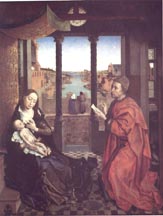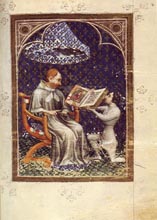 |
[For a more extensive discussion of this image and the shift from generalized to type to individualized representation see the webpage I have constructed for the Northern Renaissance Art class entitled Court Culture: Representations of Intimacy]
The later Middle Ages witnessed the development of what we can call Court Culture. The bureaucracies and households of princes expanded dramatically during this period. The households rivalled each other in their magnificence. The prestige of the prince was directly reflected in the nature of his court. The fourteenth century witnessed a revision of palace structure with a greater emphasis laid on the division between public and private space. See the page entitled Court Design and Palace Structure. Membership in a prince's household was a sign of high status. This development of the court had a direct impact on artists. Beginning in the fourteenth century artists began to become members of the households of princes. We have for example the case of Jean Bondol who served as the painter of the king under John the Good and Charles V of France. An inscription on the page facing a miniature showing Jean Vaudetar, a "servant to the King", presenting a Bible to Charles V identifies John of Bruges (or Bondol) as the painter of the miniature:
 |
[For a more extensive discussion of this image and the shift from generalized to type to individualized representation see the webpage I have constructed for the Northern Renaissance Art class entitled Court Culture: Representations of Intimacy]
From the later Middle Ages through the Early Modern period, the position of Court Artist was a great honor for artists. The status associated with the position played a significant role in transforming the social position of the artist from the role of artisan in the late Medieval craft industry. Artists like Limbourg brothers, Jan Van Eyck, Mantegna, Piero della Francesca, Leonardo da Vinci, Albrecht Dürer, Hans Holbein, Michelangelo, and Peter Paul Rubens, just to name a few, all held at one point in their careers a position at court. Velazquez's famous painting entitled Las Meninas reflects the continuity of the importance of this position into the seventeenth century Spanish Court of Philip IV:
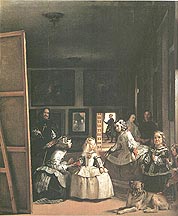
The court artist during the later Middle Ages was considered a member of the familia or family of the prince. Members of the household would be given the title "valet de chambre," or chamber servant. The term "chamber" refers to the bedchamber of the prince. During the period the chamber became the center of power. The connection of the artist to the prince was a personal one. The artist like any member of the household would have to swear a special oath of loyalty to the prince. On the death of the prince, the artist's position was lost. The artist would frequently receive an annual salary or pension. This payment was not for specific work, but for the availability of the artist to be on-call to do work. Court artists would also regularly receive a house and clothing so that they would be able to live in a manner appropriate to their position as a member of court.
The most important benefit associated with the court position was the status of being a member of the familia and having direct personal contact with the prince. Intimacy with the prince was a sign of high social status. As the power of European monarchs increased during the early modern period, the stature of the court painter increased as well. This is important to bear in mind when we look at paintings like Velazquez's Las Meninas illustrated above.
Among the court artists during the early fifteenth century is Jan Van Eyck who was a member of the court of Philip the Good the Duke of Burgundy. For modern accounts of his role as court painter see the webpage I have devoted to excerpts from recent scholarly discussions about the career of Jan Van Eyck. It is important to note that none of the works of Van Eyck that have come down to us were directly made for the Duke of Burgundy. The inventories of the Duke's collections do not list works by Van Eyck. Like many of the court artists of the period, the majority of the work that Van Eyck did for the Duke seem to us to be of an ephemeral nature, like painting of coats of arms and decorations that would be part of lavish court festivities. Jean Hennecart, a painter-illuminator at the court of Burgundy, was paid by Charles the Bold in 1457 for designs of an elaborate gold cross and two alternative designs for a silver falcon. In 1470 he created thirty alternative designs for coins, and along with Pierre Coustain, Hennecart supervised a large team of craftsmen responsible for the decorations made for the marriage of Charles the Bold and Margaret of York in 1468. The works included in the inventories of the Duke of Burgundy are largely lavish metalwork objects, tapestries, and illuminated manuscripts. These objects reflect the categories traditionally associated with aristocratic patronage. The works we associate Van Eyck with are panel paintings in oil frequently altarpieces or portraits. The novelty of this category of object should be emphasized. Although we well know that oil painting will become the dominant media in Western art, at this period it did not have high status. It is important to observe that the materials associated with the traditional aristocratic patronage had intrinsic value. Oil paintings like those of Van Eyck while representing costly objects had little intrinsic value. When the oil painting will achieve high status and associated with aristocratic patronage will be when the identity of the artist and the style become of value.
Many of the works associated with Van Eyck can be connected to members of his court. For example, the so-called Rolin Madonna represents Nicholas Rolin, the Chancellor of the Duke of Burgundy:
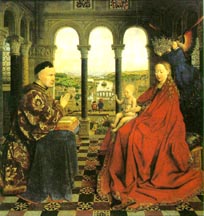
The famous double portrait traditionally entitled the Arnolfini Wedding Portrait depicts Giovanni Arnolfini and his wife Giovanna Cenami, both Italians and representatives of the important role Italian merchants were playing in the economic life of the period. Arnolfini's status was reflected in the position he held at the court of Burgundy.
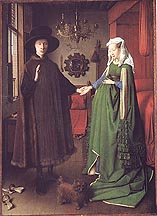
It is important to note that the patrons of Van Eyck's paintings were members of this upper bourgeois class of people who served as functionaries in the court. Their status was not based on birth, but on their own merits and their personal ties to the Duke. The same would be true for Van Eyck. Court etiquette would suggest to have a painting by Van Eyck, one would have the direct permission of the Duke. We should thus see these paintings as status symbols.
At the time of Van Eyck, there were distinct social roles that an artist could fill. We have his case as court artist, but we should also not forget the urban craftsman. The towns of the Netherlands had their own artists frequently forming a painters guild. Artists like Robert Campin had careers serving as town painters in towns like Tournai or Rogier Van der Weyden serving as the head of the painter's guild in Brussels. The works of these artists would be regularly made for the upper-middle class citizens of these towns who were independent of the aristocracy.
A comparison of a work of Jan Van Eyck like his Rolin Madonna to a painting associated with Robert Campin like his Madonna of the Firescreen or the Merode Altarpiece is an effective way of coming to terms with the different social roles of the artists and their competing ideologies:
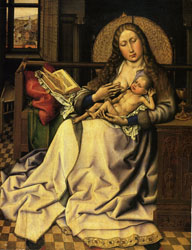
|

|
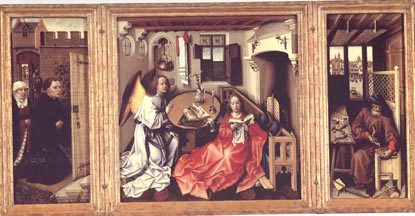
Try comparing these works. What do you notice about the social realities shown in them?
Another painting to consider is Rogier van der Weyden's St. Luke Drawing the Virgin, a work that Rogier perhaps did as his "masterpiece" made for the Guild of St. Luke in Brussels about 1435-40:
